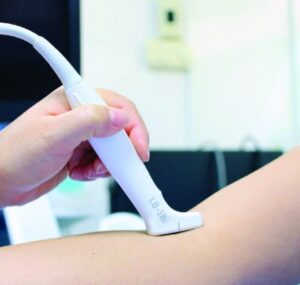
Ultrasound guided IV insertion changes the way vascular access services are provided. Ultrasound guided IV insertions are safer and faster for all patients, and particularly with patients who have problems with IV insertion or longevity.
The utilization of ultrasound guidance for all vascular access, including Peripheral IVs, Midlines, and PICC lines has been rapidly increasing. The results are extremely promising. In a show of support for utilizing this technique, the Association for Vascular Access posted a position paper recommending that a properly qualified vascular access specialist or other applicable healthcare clinician use real-time ultrasound for all vascular access procedures.
Though ultrasound technology itself isn’t new, the implementation of ultrasound guidance for IV and peripheral line installation is a relatively new application in the last decade. Initial study results suggest that utilizing ultrasound guidance can be beneficial in a variety of situations. The first is speed and accuracy of insertion. Instead of struggling with difficult sticks or multiple attempts, experienced ultrasound users are often successful on the initial stick, resulting in faster and more comfortable line placement, especially with those patients who have venous issues or scarring.

Secondly, utilization of ultrasound guidance for IV insertion seems to result in much less irritation and fewer blown sites than traditional methods. Again, venous wearing and irritation have become significant concerns in vascular access practice, and reducing inflammation and irritation to the site is an essential part of providing comfortable and successful vascular access. For those patients who are receiving multiple IV treatments on a regular schedule, or over a long period of time, preserving the vein for future use is of paramount concern, and the ultrasound guided technique may significantly help that issue.
AccessRN has been utilizing ultrasound guided techniques for years now, with a high degree of success and patient satisfaction. We stand by the AVA position paper and consider ultrasound guided IV insertions our standard of care. Instead of utilizing ultrasound exclusively for difficult patients with vascular issues, we see it as a tool for a wider variety of patients in settings across the continuum of care. This results in more comfortable IV placement for patients with less vascular damage.



